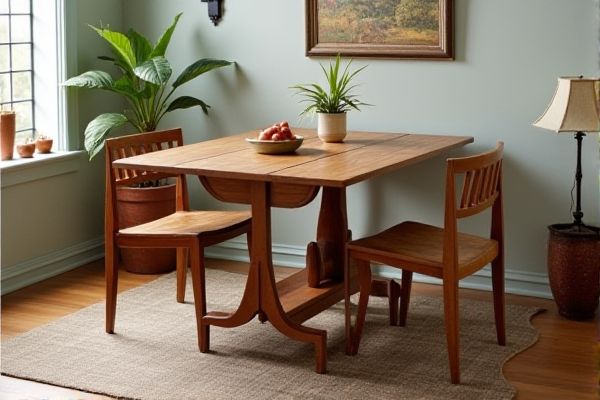
Leaf tables are basic, single-tier tables without any extendable parts, ideal for compact spaces; drop leaf tables feature hinged leaves that can be folded down to save space or extended to increase surface area when needed. Explore the article to discover which option perfectly suits your space and lifestyle needs.
Table of Comparison
| Feature | Leaf Table | Drop Leaf Table |
|---|---|---|
| Definition | A table with fixed leaves that fold down from the sides | A table with hinged leaves that drop vertically to save space |
| Leaf Mechanism | Leaves fold up or down horizontally | Leaves drop down vertically by hinges |
| Space Efficiency | Moderate space saving when leaves are folded | High space saving; leaves drop close to wall |
| Typical Use | Expandable dining or worktable | Wall-mounted or freestanding for compact spaces |
| Setup Complexity | Simple folding setup | Requires secure mounting and easy leaf drop |
| Design Variations | Available in various sizes and shapes | Often designed for narrow or small rooms |
Introduction to Leaf Tables and Drop Leaf Tables
Leaf tables serve as foundational data storage structures in database systems, optimizing query performance by storing detailed records at the lowest hierarchy level. Drop leaf tables refer to a specific operation or approach where these detailed tables can be removed or dropped without affecting the integrity of higher-level aggregation tables. Understanding the distinction between maintaining and dropping leaf tables is crucial for efficient database management and storage optimization strategies.
Defining Leaf Tables: Features and Functions
Leaf tables are specialized database tables designed to store actual data records in a data warehousing environment, forming part of a dimensional model typically used in star schemas. They feature direct data storage with indexes optimized for query performance and support efficient data retrieval through primary and foreign key relationships. Drop leaf tables function as commands or processes to remove these leaf tables from the database, facilitating schema changes or cleanup tasks without affecting the overall data model integrity.
What is a Drop Leaf Table? Key Characteristics
A drop leaf table features hinged sections called leaves that can be folded down to save space or extended to increase surface area, making it ideal for flexible room layouts. Key characteristics include its versatility, compact storage when the leaves are dropped, and ease of use for adjusting table size according to your needs. This design maximizes functionality without sacrificing style in small living spaces.
Space-Saving Benefits of Leaf and Drop Leaf Tables
Leaf tables offer significant space-saving benefits by folding down the hinged section to create a smaller footprint when not in use, ideal for compact living areas. Drop leaf tables similarly maximize room efficiency by allowing you to drop one or both sides, adapting the surface size to your needs without occupying permanent space. Your choice between these designs can enhance functionality while conserving valuable floor space in tight environments.
Style and Design Differences: Leaf Table vs Drop Leaf Table
Leaf tables feature fixed leaves attached via hinges, allowing extension by simply lifting and swinging out the additional surface, maintaining a classic and sturdy design. Drop leaf tables incorporate hinged leaves that hang vertically when not in use, supported by brackets or swing-out supports when extended, offering a space-saving and versatile style ideal for smaller areas. The design choices between leaf and drop leaf tables prioritize either ease of extension or compact storage, influencing the overall aesthetic and functional appeal.
Versatility and Use Cases in Modern Homes
Leaf tables offer versatility in modern homes by functioning as both compact side tables and expanded dining surfaces through extendable leaves, ideal for hosting guests without taking up permanent space. Drop leaf tables maximize space efficiency in small living areas by allowing one or both sides to fold down, making them perfect for apartments and multifunctional rooms. Their practical designs cater to various use cases, from casual coffee tables to formal dining setups, blending adaptability with stylish functionality.
Durability and Maintenance: Which Lasts Longer?
Leaf tables provide higher durability by ensuring data persistence through distributed storage and replication, reducing the risk of data loss during failures. Drop leaf tables, while easier to maintain due to their transient nature and simplified cleanup processes, often sacrifice long-term data retention and consistency. In terms of longevity, leaf tables last longer because their structure supports continuous availability and robust data integrity.
Cost Comparison: Leaf Table vs Drop Leaf Table
Leaf tables generally cost less due to simpler construction and fewer moving parts, making them an economical choice for budget-conscious buyers. Drop leaf tables typically involve higher costs because of the added hinges and mechanisms that allow the leaves to fold down, increasing manufacturing complexity. Your decision should weigh the initial investment against the flexibility and space-saving benefits offered by drop leaf designs.
How to Choose the Right Table for Your Space
Choosing the right table for your space depends on available room and intended use; a leaf table offers flexible expansion with removable sections, ideal for accommodating extra guests without permanently occupying space. Drop leaf tables feature hinged leaves that fold down, making them perfect for compact areas where saving space is essential without sacrificing surface area when needed. Your selection should balance daily functionality with occasional needs, ensuring efficient use of space and adaptability.
Conclusion: Which Table Suits Your Needs Best?
Leaf tables provide direct access to partitioned data, offering faster query performance and streamlined management for specific datasets. Drop leaf tables eliminate the physical storage of data by linking to external sources, ideal for scenarios requiring flexibility and reduced storage overhead. Your choice depends on whether you prioritize high-speed data retrieval with leaf tables or adaptable storage solutions with drop leaf tables.
 homyna.com
homyna.com